Chapter 14
(translated from French)
Morale and Handicap :
the recognition of the human form
IV - 14
The idea of this communication is based on the fact that discussions on handicap seems to misunderstand the meaning of disability in traditional societies. Of course, our representation of handicap is different. The meaning of disability in traditional society, which involves a discrimination, seems incomprehensible to us and shocks us. The question is to find out whether this discriminatory representation, which is foreign to our basic morality has truly disappeared. If there was an insurmountable frontier between the two conceptions of handicap, my communication would have no place in a conference where we reflect on ways of improving how we take care of the handicapped. Rather, it would concern a sort of archaeology of representations. But we can also think that our perception does not erase, but rather is superimposed onto the traditional perception. In order to decide between the two, it seems necessary to attempt to enter into this archaic logic and so it is the representations of handicap and their recent evolution that will be the centre of my concern. The interest in calling forth here these representations rests on the idea that this (hidden) conception of disability today is one of the factors that slow down social action.
The object of the communication-in summary- is thus to understand:
-what disability means in the majority of traditional societies- which I will try to interpret here
-and how it continues to make sense today, by virtue of these same values, when indeed even the canons of modern ethics would contradict what we can observe in these societies.
I will start by a personal example that, it seems to me, gathers together everything that is at stake in the representation of the exception. Why are twins (I, myself, am the proud father of twins) - twinship not obviously being an anomaly for us- the object of such contradictory assessments in numerous African societies for example: sometimes having a positive connotation, sometimes a negative one? I will recall, concerning twins, since my intention is to relativise our beliefs, that if the elder of a couple of twins is, for us, the firstborn, this representation is not universal. It can be the younger twin, since it is considered as the first one conceived, its precedence being notably demonstrated, according to a comment collected during field research in Madagascar, by the fact that “ it's he who has built the house” (he comes out with the placenta). The Belgian press wondered about, a few months ago, on this not Byzantine question when it came to naming the heir of the Belgian throne by virtue of the principle of primogeniture ( the Salic law having, furthermore, been revised in 1830). Princess Mathilda was supposed in effect to be pregnant with twins. The idea- the evidence- by which the legitimate claimant would be the firstborn has been contested by virtue of the ancient medical adage that states that the first child conceived is born second…
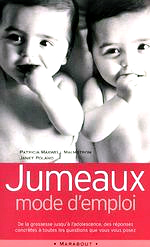
In certain African populations, therefore, the father of twins is “cadeauté” when he arrives at the market: he was given some fruits or a little present, because we think that he maintains a privileged relationship with the powers of fertility- that we hope to gain by these gifts. In effect, to have two when we've been expecting one is a blessing. “What have I done for God, a mother of twins exclaims, to deserve this favour?”
Elsewhere, on the contrary, twinship is a sign of malediction and it happens that one of the two children is sacrificed. Certain Malagasy children adopted today in Reunion Island are twins abandoned by their parents and taken in by religious institutions. In the past, in the Mananjary region, on the East coast, one of the twins was laid down at the exit of the Cattle park. (a Malagasy film Quand les étoiles rencontrent la mer by Raymond Rajoanarivelo, illustrates this ancient tradition which is practised at the expense of the child born on a day of eclipse).
Behind this apparent contradiction a profound logic is expressed, revealed by this remark by a peasant showing the ethnologist his dog who had just given birth: “You see: she's only had one puppy. She is a yowo!” The peasant from the Danube (this peasant from the Logone) explained to his interlocutor, who was surprised to hear this word that he'd just heard being applied to a mother of twins, “But do you not see that it's the same thing?” In effect, the female human is normally uniparous and the female dog multiparous. It's the irregularity that is problematic. And the most correct meaning of the word yowo, translated by “forbidden”, “taboo”, is actually irregular. (We can make the same type of comment on the translation of certain Biblical terms when, for example, the Hebrew word tebhel is translated as “perversion” when it signifies “confusion, mixing”- see Douglas, 1981). I will add that in Madagascar, where twinship is fady (taboo), twins are sometimes referred to by the expression kamban'amboa (“dog twins”)
What, therefore, does regularity mean? It means the assurance of re-production.The reproduction of the same thing. I am the father of twins- of mixed twins, since they are boy and girl. During the summer debarking of the family to the Charentes countryside, a grand-mother, going into complete raptures about the grace of the twins, added soon afterwards: “ I, too, had twins, a boy and a girl. But don't worry! My daughter had six children!” Here is the problem that irregularity provokes, even when it constitutes an advantage: it carries the risk of stopping fertility. And it's a common idea, in fact that the girl of a couple of twins risks being sterile… (I'm not ignoring that embryonic hormonal biochronology might also be required in this case.)
This simple and fundamental idea is in effect, constituent of the representation of the world of traditional societies, which are founded on the reproduction of natural cycles, notably agricultural cycles. It's because things happen in the same way that we have good reason to expect the reproduction of what has already happened. Attentive to natural regularity, agricultural communities represent, furthermore, social regularity and the regularity of germination cycles under the same concept. The exception there is disorder and the threat of generalised subversion of re-productions. The physical and the moral order are one and the same thing. Kalos kagathos. In this conception where the government of men and the government of things are not distinguished from one other, infirmity is perceived a sign of wrath from the gods. In Homer's language, teras (which gives us teratology) means “sign” and the Latin monstrum is related to moneo “to warn.” Monsters represent for Tite-Live “the act of nature that has confused and muddled up the seeds” (XXXI, 12, 8) and the prodigy, according to Festus (122,8) is “that who shows the future and warns of the will of the gods.”
Among the Bambara, in West Africa - to conclude these remote examples- “ we consider that the body of an Albino is gifted with special powers. Whoever has his head, will have a numerous family and prosperity […] This value attributed to the Albino makes him a victim of choice for sacrifices […] His nyama is such that it can be sacrificed without prayer, the act itself forming a useful invocation” (Dieterlen, 1951:88) It's his exception itself, that defines his religious status. We can find on the Internet documents and testimonies that show that Albinos are still the object of severe segregation in Africa. With, furthermore, a characteristic ambivalence- the negative aspect prevailing- by virtue of the logic I have stated. The Malian singer Salif Keita, himself an Albino, created in 1990 a foundation “SOS Albinos” whose object is to fight this discrimination.
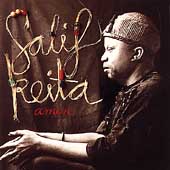
*
The revolution of modernity obviously consisted in opposing to this logic of appearances, associated with the cosmic representation of the human form, a moral based on the recognition of the person. The moral revolution has displaced the morality of the meaning of the physical form (the Greek formula that associates beauty and truth meaning that the regularity is the virtue) to the belonging of the human community by the sole fact of birth. The missionary signifies this radical separation of man and nature [in] traditional society by taking the infirm under his protection. Interest towards disability manifests here the equality and the indifference of every form. My question is obviously one of the permanence of former representations under today's morality. As I have already stated, it is therefore the representations of handicap and their evolution in our own environment that will be the centre of my interest.
It is essential to note, as I will show by several examples, that our basic moral facts are relatively recent, that they are far from being shared by everyone and that they sometimes bring up injunction more than conviction.
Perhaps, to start with, it might be useful to recall that, until 1980, one couldn't be integrated into civil service in France if he measured less than 1m 40. Even if the medical representation of the handicap and if the religious magisterium have profoundly changed the approach, stigmatisations have not disappeared. An article from Le Monde dated 10th January 1980 reports, under the title “A village of Gard against the handicapped, the intolerable disabled”, the content of a letter that the mayor of Vestric-et-Candiac had just addressed to the parents of a Belgian handicapped girl, boarder at an institution of the National Belgian League of Aid to The Cerebrally Paralysed, established in the chateau in Vestric. I refer to these words in the silence of my written communication (vide infra), to highlight the fact that this “popular” representation of handicap proves to be steadfast even where we least expect it, in what we call “high society”, where “political correctness” reigns. Two examples.
The British Royal Family - I'm not going to talk here about the “gaffes” to which the Duke of Edinburgh is accustomed, more or less everywhere he goes on official visit and about which the Daily Express of 15 October 1987 has set up a methodical list on the world map - has amongst its members a German cousin of the Queen who is mentally handicapped and of whom Burke's Peerage completely ignores the existence (meaning that one has forgotten to declare her to the British high society). A son of the Count of Strathmore, brother of the Queen Mother, has two daughters who have lived as recluses in the Royal Earlswood Hospital, near London, ignored by everyone until a “tabloid” [?] revealed their existence. One of them died in 1986 at the age of 70. She was buried in the cemetery neighbouring the hospital and her grave is marked by a simple cross provided by the administration: The director of the hospital declares that the two women have not received any visits since the 1960s. The affair is even more revealing as the Queen Mother herself was patron of the principal British charity dedicated to… the mentally handicapped. How could she have ignored the fate of her two nieces? The secretary general of the organisation explains: “There is in all this the vestiges of the Victorian era; it was more or less acceptable to keep silent the existence of children that one would have called abnormal.”
A story from the Agence France Presse of October 1993, entitled “Serious faux-pas in the Conservative campaign” in Canada, gives an illustration of this permanency of representations. “The administrative staff of the Conservative Prime Minister Kim Campbell did their best […] to minimise the negative effects of the enormous gaffe committed with the diffusion of televised “spots” exploiting a physical handicap of the Liberal leader Jean Chrétien. Already largely overtaken in the polls by the Liberals, a week or so before the General Election, the “Tories” could have still lost ground in public opinion following this faux-pas. Mrs Campbell, who was obviously embarrassed, apologised to Mr Chrétien. One of the televised “spots” included several large close-ups of Mr Chrétien whose left side of his face is partially paralysed -the after-effect of a childhood illness. “Is this a Prime Minister?” a voice-off asks before suggesting that if the Liberal leader didn't answer questions, it's because he hadn't understood them. The other “spot” stressed heavily the physical handicap of Mr Chrétien, with photos to support this, and finished with the commentary of a women affirming that she “would be very embarrassed” if he [Mr Chrétien] became the Canadian Prime Minister.” This “very embarrassed”, expressed by a feminine voice, refers implicitly to the illusions stated above as to the effects of handicap on gestation and reproduction…
Basically, it seems to me that the improvement of the condition of the handicapped should start by this acknowledgement of relative powerlessness that compels us to make even more effort: no more than moral rules don't change “human nature”, legal and administrative dispositions that aim to improve their fate shouldn't exhaust our duties towards the handicapped.
I will report here on the Masters thesis of a Cameroonian student, settled in Reunion Island, on the situation of the handicapped, which concerns us on this last point. On Reunion Island, says this student, we see signs everywhere aimed at the handicapped, but we don't see any handicapped people anywhere… which constitutes, in effect a singular difference with African towns where, in the large towns at least, the infirm come near town centres and supermarkets, where the notables, ex-pats and tourists do their shopping to bombard them by begging. They are visible and hide themselves so little that they make a means of pity out of the exhibition of their difference. Paradoxically, according to this African student, the situation of the handicapped is more favourable in Africa than in Western countries… It's a judgement that is worth meditating on. What struck her is, I think, essentially, the confinement which the handicapped are subjected to here, where they are often more or less held hidden (cf. the judgement of the grocer of Vestric-et-Candiac and the “Victorian” situation), whereas in Africa, and I noticed it as well in Madagascar, even if one makes fun of the infirm, we are not embarrassed to admit that we are related to them. This young Cameroonian being an urbanite, and not a villager, I don't think has truly understood the situation of the infirm in the villages. But even in the village, this situation is more nuanced than we would have thought. Certainly, the handicapped man is stigmatised for reasons I've already mentioned, but the reasons that stigmatise him also form part of his defence: He has “the eye” and we fear him. These reasons no longer exist in our representation and leave him in some way, with no defence…
The question is to find out what these counter-examples mean and what importance it is necessary to give them. Basically, we are in a situation of moral and anthropological transformation whose signification we can summarise by the nature and recent evolution of the circus. The circus is the meeting place and exhibition, for the use of ordinary man, of the limits of humanity. We know that not very long ago we used to exhibit certain types of infirmity in the circuses under the title of “curiosity”, like the Elephant Man, about whom David Lynch tells the story in a famous film. The Bearded Lady has for a long time been a winner, but also Siamese sisters or brothers, the Geek, the wild man, devourer of raw flesh, etc. In the 1840s, Phineas Taylor Barnum, show entrepreneur, founded the first travelling circuses. His Grand Congress of Nations (1884) illustrates the entry of the exotic man into these theatres of “curiosities”. The superiority of the norm is unfurled in concert with the superiority of the White man. There is an anthropological function of the circus in this exhibition of the exception and of difference: we come to get an eyeful and comfort ourselves in our normality and our superiority. There was: because this configuration has changed. In October 1995, that's only yesterday, the Conseil d'État forbade an exhibition of “flying dwarves”, a show which “by its very purpose, undermined the dignity of the human person”. It has also considered that it was within the power of the mayor's policy to forbid events that included such an attack, because “human dignity, as it is strictly understood, is a composite of public order.” “Public order” has thus changed. When the Elephant Man, shown as a beast, starts to sing the psalm of Isaiah “The Lord is my Shepherd…” (Isaiah 33, Lord, righteous judge), it is quite obvious that humanity holds on to the ability of enunciation and to the conscience of transcendence, and not to physical form.
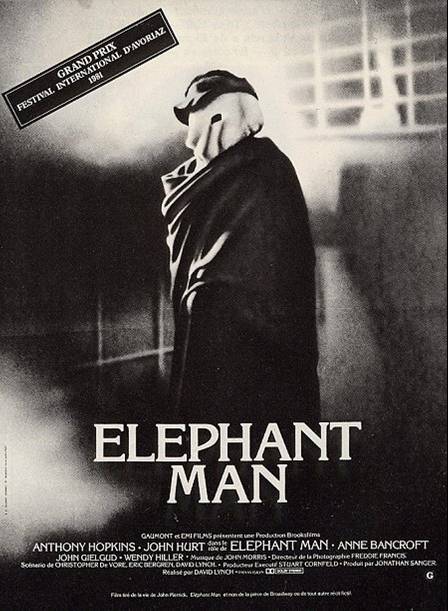
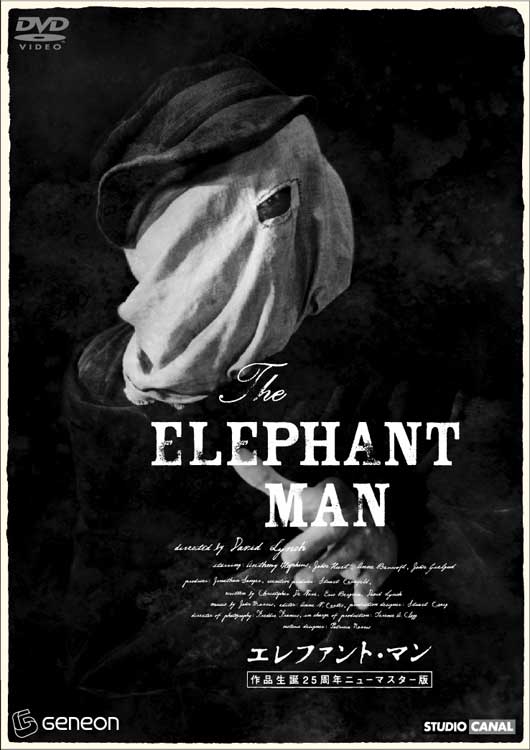
(“Speak and be baptized !”, was the cardinal of Polignac's invitation to a primate in the Botanical Gardens). This is the moral revolution.
Tod Brownings precursory film (who himself occasionally was a contortionist in a circus), Freaks (1932), represents this moral inversion behind the scenes of the circus itself, which is the place favoured by exceptions, by presenting a story about the two extremes of humanity and by exposing the monstrosity of the superhuman as well as the humanity of the disabled.
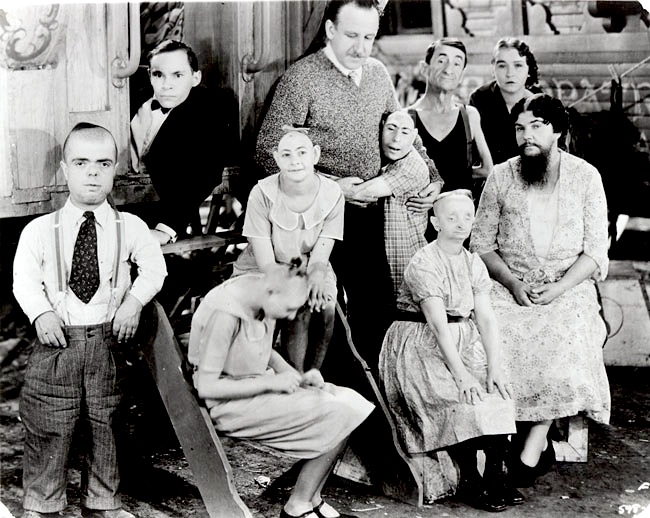
Le renversement anthropologique
Tod Browning au milieu de ses acteurs
www.olgabaclanova.com/freaks_show_gallery.htm.
The moral of the story that Browning presents, is less a matter for the prodigy of the barker displaying to onlookers, in the beginning of the film - we learn that the trapeze artist was transformed into a chicken -
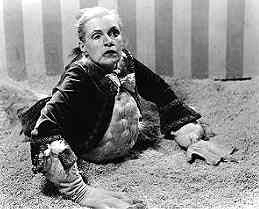
than for the anthropological inversion, which consists of making the ugly the judge of beauty and the criteria of what is real. The Venus of the circus, the trapeze artist, has thus decided along with Mister Muscle, her alter ego, to get possession of the dwarf's fortune by putting on an act of marriage.
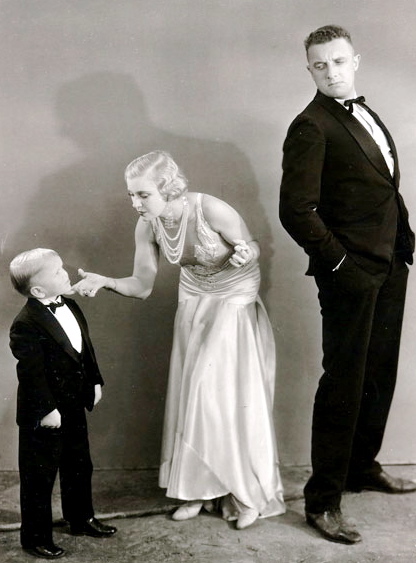
Kalos kai kakos, Kalos kai aiskhros
www.olgabaclanova.com/freaks_show_gallery.htm.
The scene of the wedding reception constitutes the most high tense moment of the film. Gathered around the wedding table, all the monsters (freaks) of the circus pass round a cup from which everyone drinks in turn. The turn of the Venus of the circus arrives. A dwarf perched upon the table hands her the cup. The spectator imagines that she will drink in the cup to realize her criminal intentions. But no: she stands up with a gesture illustrating her disgust, exclaiming: “You are monsters!… It was a game!” Her response to the communion cup is to pour poison in the dwarf's, her fiancé's, glass. At the end of the film, a dissociation between physical appearance and its moral signification is brought up: the “disabled” are messengers of truth, Angels (etymologically) and Furies at the same time. When they take the law into their own hands in an outburst of natural elements, it's the moral darkness of this Venus, all smooth and white, who defies the element by hanging in the air, which becomes obvious - she finds her true place at the bottom of the ladder of beings in the form of a chicken… In reality, the process of identification takes effect in the film as soon as we enter behind the scenes of the circus and in the familiarity of these beings who are constrained to make their living out of what stigmatises them. We see their feelings, their rituals and the ordinary life of these extraordinary beings. They have a mother: “They are my children!”, replies the old lady to the horrified exclamations: “Monsters!” of people passing by as they are taking a walk in the forest. They have a personality separate from their physical appearance.
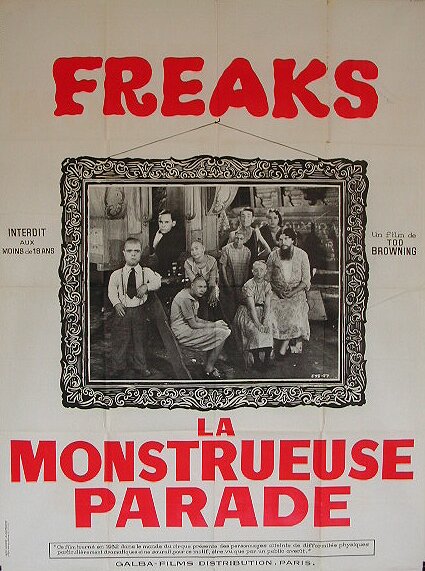
The problem is thus this, beyond the meaning that can be predicted from the irregularity set out above, the nature of this psycho-cognitive phenomenon, which immediately involves a recognition of the ways of denial and which is unravelled by a gesture of physical repulsion - in such a way that the trapeze artist of Freaks can no longer pretend. The “manager” of a hospital in Paris, announced that 18 000 women have given birth during his service and declared on a TV programme (22nd of November 1982): “With the experience of my already long career {…} normal, orderly people kill their child when they realize that he is abnormal”. Could these reactions, less exceptional than what we might think, if we believe this privileged observer, reveal a permanency of a “naturalist” and “conservative” representation of the human form?
A neuralgic point of the considered mechanism without a doubt lies - emblematic in the reference I just quoted- in a primary process of recognizing oneself (recognizing oneself in ones own child). When language states that ugliness and deformity are “repulsive” or “repugnant” (I-E *peug: hit) and thus by nature are active and aggressive, it ascribes them an action against which a simple spectator is supposed to be obliged to defend himself. Hence the “repulsion” prejudges a first attraction, a recognised identity which calls the self-image into question: which “makes you feel sick”, because it is supposed to subvert the elementary attitude by a reflex. The “News in Brief” column in newspapers often relates these sordid stories where - in reality- the handicapped are victims of aggressions. Most of the time of people low in status and who remodel their own social regrading on the handicapped.. .
“Vous êtes sans ignorer [sic] puisque vous l'avez peut-être éprouvé vous-même que ce genre de maladie des enfants provient souvent d'une émotion de la mère en état de grossesse et même pendant l'allaitement.” These words I quoted earlier are placed in the register of a belief according to which the simple reproduction of identity, the same in the human form, is involved in the simple spectacle of “deformity” - in the popular language the height of ugliness is significantly supposed to “faire tourner une couvée de singe”… The moral comes up against this first cognitive fact here, in accordance with which to classify means to exclude. The rules are a protection against the intrusive disorder. Dietary rules as they are set out in Leviticus, for example, are essentially cognitive rules applied to customs: ”What's good for the mind is good for the body”. But this classification is not exhausted in a sole intellectual process. The fact that religion formalises its necessity (what is yowo in the example of uniparity: “Be holy, as I am holy”, in Leviticus in regarding categories…), the contrast between pure and impure, far from justifying a classification afterwards, maybe hallmarks the fact that a classification before all classification would exist, a primitive form of apprehending a fellow creature.
To prevent exclusion and to be able to put forward responses to it as well as in order to educate perception of difference, moral and material action for the handicapped requires, in the first instance, it seems to me, the consideration of the anthropological antecedents presented here.
Thus, the known and recognized ways of action would possibly be even more legitimated. The pedagogic and scientific approach first. A Cameroonian who has created an association to defend albinos explains: “Two black people have a white child: it is impossible (for those who don't have the scientific explanation) to consider such a thing rationally”; In the case of albinism, it is comforting to know that the scientific approach manages not only to explain it, but it also gives therapeutic hopes. Albinism is a hereditary affection (transmitted by the recessive autosomic mode) which is characterised by a defect of the melanin synthesis. Isolation and the (theoretical) possibility of cloning the gene of tyrosinase gives us hope of a treatment.
But if it is also the inner nature, the self-image that is affected by this difference, the pedagogical action for a better recognition of the handicapped should not limit itself to the disclosure of material, genetic or embryological causes… which are the origin of malformations- to exempt the handicap from all symbolic significations-, but it also has to consider the fact that the constituents of identity are involved in this confrontation with difference. How could a difference stop being one? In order to invalidate this impulsion of retraction before deformity, taking into account the constraints I just reported, we obviously need to assimilate the difference in the social environment. It turns out that, instead of herding the handicapped into the ghettos or “keeping them at home”, their prepared and supervised integration in schools, for example, would make them appear as a natural expression of diversity. Experiments in classes in the north of France, where schoolmates took care of handicapped children, proves this to be true. There is a concrescence of diversity - the fact of growing up together - which makes difference natural…
On the occasion of their 150th birthday, the Red Cross covered the walls of Paris with the following slogan: “For 150 years, the Red Cross has been making man more human”. By way of a conclusion, I will express this paradox: it seems to me, that to make men more human, in the first place we need to endeavour to understand according to which constraint the inhumanity of man can prosper and make them somehow “less human”…
_______
Note :“You are aware, the Mayor writes, probably due to your personal experience, that this type of children's disease is the result of the mother's emotions when pregnant or even when breast-feeding.” The journalist reporting these words asks if “thus the sole sight of a handicap would “curdle your blood”, “makes milk go sour” ? “I'm not a doctor… maybe”, replies the deputy mayor. If it is possible to find in the village in question some inhabitants who, in the terms of the director of the institution, “want to do the right thing for the love of goodness” what will not be invented to chase away “the handicapped” ? A municipal bye-law warns that “the presence of these sick persons on the public roads or in public places will arouse diverse reactions”. The deputy mayor tells that “this summer, the campers came to complain. It's understandable, on a holiday, it's not amusing”. He adds: “If you saw all of them in a line in front of the château this summer… it is not for our children's eyes”. A fisherman recounts: “One day, I pulled up to let them pass. There were three handicapped people in a small car and other handicapped people were pushing them, you can imagine the scene”. A young girl from the village is troubled about these strangers “who should go back to where they came from”. A lady from the grocery shares her opinion: “I had a handicapped sister, we preferred to keep her at home, rather than to show her to the whole village”. Finally, these beings are not only an affront to good taste and aesthetics (“not amusing”, “you can imagine the scene”), an embarrassment for children's good education (“it is not for our children's eyes”), a risk for the reproduction of species (a danger for pregnant women,) but they also create sanitary complications; the mayor explains that “ the pipes of the water purification plant are fouled up by their swimming pool and the penicillin that lies at the bottom”. Even the priest finds that these “handicapped” are bothersome and had not wanted that their “carriages obstruct his church for the Christmas Mass”. He only accepted three handicapped “sitting down, like the rest of us”. This trouble of categories due to handicap seems to have spread as far as the printing house on the “Rue des Italiens”, as this peculiar article of the high standard paper like Le Monde is, (moreover written by a journalist who destined for great success) contains no less than seven typographical misprints and finishes with an abrupt end.
[Paper presented at the conference “Handicap, cognition and taking individual responsibility: aspects of research on respect for a person” under the title: “To understand the signification of disabilities in traditional societies, an obliged prerequisite for taking responsibility over handicap in modern societies?” University of Provence, University of Mons-Hainaut, La Baume-les-Aix, 21, 22, 23 November 2001, organised by the Assiociation of Young Researchers in Cognitive Sciences (Accion - Électre).]
|
|

